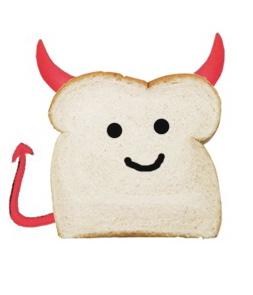why is white beard so bad for you ?
Replies
-
My main problem with it is that it's just not GOOD for you. There is little to no nutritional value in a slice of white bread, whereas, with whole wheat, you do at least get some nutrients and fiber. It's basically just empty calories.
You were saying?
Once again science and research prevail. Just waiting for someone to throw in the "glycemic index" so we can have another laugh...
Damn. Late for the party.
White bread IS the devil. See ^
My wheat bread is higher calories then white?0 -
My main problem with it is that it's just not GOOD for you. There is little to no nutritional value in a slice of white bread, whereas, with whole wheat, you do at least get some nutrients and fiber. It's basically just empty calories.
You were saying?
I found something similar on http://www.bakeinfo.co.nz/Facts/Nutrition/Nutrition. I was curious as well as A LOT of sources state generically that whole wheat is so much more nutritious, but it's nice to see actual numbers. Not as drastic as I was led to believe.0 -
It's not white beard that you need to fear.
It's the raccoon.
I am not sure if I like the man or the raccoon the most. Both are AWESOME!0 -
Okay, let's look at the ingredients of a relatively high quality supermarket bread, Pepperidge Farm Farmhouse White:
Unbromated Unbleached Enriched Wheat Flour (Flour, Niacin, Reduced Iron, Thiamine Mononitrate [Vitamin B1], Riboflavin [Vitamin B2], Folic Acid), Water, High Fructose Corn Syrup, Yeast, Contains 2 Percent or Less of: Honey, Nonfat Milk (Adds a Trivial Amount of Cholesterol), Soybean Oil, Butter (Adds a Trivial Amount of Cholesterol), Lower Sodium Natural Sea Salt, Salt, Calcium Propionate and Sorbic Acid to Retard Spoilage, Wheat Gluten, Wheat Protein Isolate, Monoglycerides, Wheat Flour, Malted Barley Flour, Enzymes.
So, we have standard enriched white flour -- this is the common form of flour in the US. That the flour is unbromated and unbleached is good. Second ingredients is water but then things go downhill from there.
High Fructose Corn Syrup, which is sugar
Yeast, which is okay
Honey, which is sugar
Non-fat milk
Soybean oil, which is fat
Butter, which is fat
Sea salt AND salt
Calcium Propionate, a fungicide
Sorbic Acid, an anti-microbial
Wheat Gluten, which enhances the texture or chewiness of the bread and can be used to make up for poor flours or gluten-free flours like rye
Wheat Protein Isolate, a texture and flavor enhancer
Monoglycerides, which are used in bread to increase loaf volume
And then, as a last item "Wheat Flour, Malted Barley Flour, Enzymes," things that were probably in a starter of some sort.
What's in my homemade white bread?
Unbleached and unbromated enriched flour
Water
Salt
Yeast
Bread does not need sugar or added fats. That after flour and water is High Fructose Corn Syrup in the store bread ingredients is troubling. Even if you do not accept the research showing the clear dangers of HCFS, as sugar it adds no nutritional benefit beyond raw energy (calories). I prefer to devote those calories to other, more nutritious ingredients.
Sadly, much supermarket whole wheat bread is also laced with sugars and fats. Unless labeled 100% whole wheat, it is likely to be chiefly white flour because white flour makes a fluffier bread, more likely to be appealing to those who like commercial white sandwich bread.
It's all about choices.0 -
And here's my store bought bread:Okay, let's look at the ingredients of a relatively high quality supermarket bread, Pepperidge Farm Farmhouse White:
Unbromated Unbleached Enriched Wheat Flour (Flour, Niacin, Reduced Iron, Thiamine Mononitrate [Vitamin B1], Riboflavin [Vitamin B2], Folic Acid), Water, High Fructose Corn Syrup, Yeast, Contains 2 Percent or Less of: Honey, Nonfat Milk (Adds a Trivial Amount of Cholesterol), Soybean Oil, Butter (Adds a Trivial Amount of Cholesterol), Lower Sodium Natural Sea Salt, Salt, Calcium Propionate and Sorbic Acid to Retard Spoilage, Wheat Gluten, Wheat Protein Isolate, Monoglycerides, Wheat Flour, Malted Barley Flour, Enzymes.
So, we have standard enriched white flour -- this is the common form of flour in the US. That the flour is unbromated and unbleached is good. Second ingredients is water but then things go downhill from there.
High Fructose Corn Syrup, which is sugar
Yeast, which is okay
Honey, which is sugar
Non-fat milk
Soybean oil, which is fat
Butter, which is fat
Sea salt AND salt
Calcium Propionate, a fungicide
Sorbic Acid, an anti-microbial
Ingredients
Organic Sprouted Wheat, Filtered Water, Organic Malted Barley, Organic Sprouted Rye, Organic Sprouted Barley, Organic Sprouted Oats, Organic Sprouted Millet, Organic Sprouted Corn, Organic Sprouted Brown Rice, Fresh Yeast, Organic Wheat Gluten, Sea Salt.0 -
whole wheat =/= whole grain. whole wheat bread is basically the same thing as white bread. my whole grain bread has about double the protein and fiber of a whole wheat or white bread.
^this.
If it's already been ground into flour, it's basically the same thing, absorbed just as quickly, etc. as white flour bread, with perhaps a little more fiber.
If you're eating actual WHOLE GRAINS (meaning, the grains are still whole as they enter your mouth) there is nutritional benefit in the forms of protein, fiber, slower digestion and absorption, more stable blood glucose, etc.0 -
It was "bad" for me because it would spike my blood sugar far more and faster than any other food. When I was diabetic, it was the most important thing I had to cut out of my diet to conteal diabetes. Whole geain brwad did not spike blood glucose nearly as much.
But if that is not an issue for you, it's not "bad," as long as you eat it in moderation.0 -
I grew up eating mostly oat bread, so I think pre-sliced white sandwich bread is too squishy and tastes icky. I eat whole grain varieties instead. I also generally find whole wheat and multi-grain sandwich bread much more filling than white. And I think that's an important thing that some of the "calories in/calories out" choir ignores. It's much easier to eat fewer calories if the food you are eating is more satisfying, and leaves you feeling full for a longer period of time. If you like the taste of white bread, and you don't get hungry again two hours after eating it, by all means keep with it!
Now if we're talking about freshly baked bread for dipping in soups and gravies and tapenade... I don't really care if it's made with white, whole wheat, rice, potato, rye, oat, or chickpea flour: it's all delicious.0 -
Best title typo ever.0
-
real question is, why would you even eat white bread? stuffs nasty0
-
Agreed.real question is, why would you even eat white bread? stuffs nasty0
This discussion has been closed.
Categories
- All Categories
- 1.4M Health, Wellness and Goals
- 398.5K Introduce Yourself
- 44.7K Getting Started
- 261K Health and Weight Loss
- 176.4K Food and Nutrition
- 47.7K Recipes
- 233K Fitness and Exercise
- 462 Sleep, Mindfulness and Overall Wellness
- 6.5K Goal: Maintaining Weight
- 8.7K Goal: Gaining Weight and Body Building
- 153.5K Motivation and Support
- 8.4K Challenges
- 1.4K Debate Club
- 96.5K Chit-Chat
- 2.6K Fun and Games
- 4.8K MyFitnessPal Information
- 18 News and Announcements
- 21 MyFitnessPal Academy
- 1.5K Feature Suggestions and Ideas
- 3.2K MyFitnessPal Tech Support Questions








